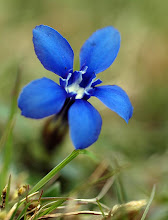The calcareous spiral tubes of tubeworms, attached to wracks and kelps that are washed up on the strandline, are a common sight on the seashore. There are several different species and the first step to identification is to see whether the tube coils clockwise or anticlockwise. If it's clockwise, then it'll be a species of Spirorbis but if it's anticlockwise, like these, and the tube has three distinct ridges, then it's a worm called Janua pagenstecheri. The coiled tube is about 2mm. in diameter.
If you watch the live worm under the microscope it soon everts its crown of transparent feeding tentacles. If you look just to the right of the tentacles you can see a brown, translucent flap. This has a dual function, closing off the tube when the worm withdraws its tentacles and acting as a brood chamber for the worm's embryos. The pink encrustation in front of the worm is a alga, not part of the animal.

















No comments:
Post a Comment
Note: Only a member of this blog may post a comment.